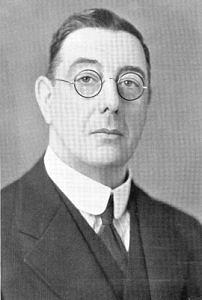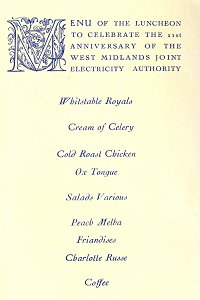THE HISTORY OF ELECTRICITY
SUPPLY IN THE AREA
|
The West Midlands Joint Electricity
Authority
But one important aspect of electricity supply had already changed and
that was the separation of electricity generation and distribution from the
supply to users. During the First World War the government had set up
a number of committees to consider different aspects of post-war
reconstruction. One of them was the Electric Power Supply Committee.
That committee found there were over 600 separate electricity undertaking in
operation most of which were too small to operate economically.
Amongst other things the average generating capacity of the power stations
was only 5,000 h.p.. That committee recommended the appointment of
Electricity Commissioners who would divide the country into District Boards
which would take over all power generation and distribution within their
area. In effect this was a proposal for nationalisation and proved a
bit too much for those times, with the result that the Electricity (Supply)
Act 1919 created the Electricity Commissioners who could set up Joint
Electricity Authorities with the agreement of the undertakings concerned.
A number of electricity undertaking in the West Midlands got
together to propose a scheme. In December 1925 the Electricity
Commissioners approved a scheme creating the West Midlands Joint Electricity
Authority which consisted of the Midland Electricity Corporation for
Power and Distribution and Wolverhampton, Walsall, West Bromwich, Cannock
and Shrewsbury Councils. The authority was made up of representatives
of the MEC, the councils, colliery owners, railway companies and workers in
the industry. Its area covered about 1,000 square miles in
Staffordshire, Shropshire and Worcestershire. The Joint Authority's
main offices were at Phoenix Buildings, Dudley Road, Wolverhampton.
|

The Ironbridge Generating Station, from the cover of the WMJEA's
booklet recording the opening. Note that this first station was
cooled entirely by river water. The cooling
towers came along with Ironbridge B in the 1960s. |
The purpose of such Joint Authorities was to
produce electricity more economically and, by interconnecting a
number of systems, enable power to be switched around the area as
supply and demand varied. The idea was that the authority
would acquire all the power stations in their area and they would
build "super stations" of a large and economical size. They
therefore took over the power stations at Walsall, Wolverhampton,
Ocker Hill and West Bromwich and set about preparing to build a
super station at Buildwas. |
This joint authority was one of the
very few which were created under this voluntary scheme. Following
the recommendations of the Weir Committee, the Electricity (Supply)
Act 1926 created the Central Electricity Board who were to establish
a "gridiron" transmission system, linking the biggest and most
efficient power stations throughout the country and supplying power
o existing undertakings. This was the start of the national
grid and the WMJEA was authorised by the CEB to build it proposed
superstation as part of the national grid. Thus the power
station, now known as Ironbridge A, was built and was opened on 13th
October 1932. (It may be worth noting that there was no
favouritism towards local suppliers. In the entire list of
contractors for the new station not even ECC appears; the only
Wolverhampton company listed is James Gibbons Ltd., who supplied
"door fittings, etc.").
The Wolverhampton Red Book 1930 reflects this change and
gives further details:
The [West Midlands Joint Electricity] authority was
established 21st
December, 1925, under the West Midlands Electricity District Order,
1925, pursuant to Sec. 7 of the Electricity (Supply) Act, 1919, for the
administration of the "Electricity District" comprising an area of
approximately 1,000 square miles in the counties of Staffordshire,
Shropshire and Worcestershire.
The Authority purchased the generating stations
belonging respectively to the Wolverhampton, Walsall and West Bromwich
Corporations, and the Midland Electric Corporation for Power
Distribution Limited, on the 1st January, 1928, from which
date they have supplied the vendors with electricity in bulk. The
Authority have inter-connected the stations with a view to the most
economical operation of the group. ...
The Ironbridge, Ocker Hill, Wolverhampton and Walsall
generating stations are "selected" stations for the purpose of the
Central England Electricity Scheme, 1928. ...
Detailed proposals for a scheme of distribution over
approximately 109 square miles in Shropshire, including Wellington,
Wenlock, Madeley, Newport, Coalbrookdale, Dawley, Oakengates and
Shifnal, etc., have been submitted to the Electricity Commissioners for
approval.
By 1936 it had become necessary to expand the power station
and this was done by building a new generating hall at Commercial Road.
|
| One of the major purposes of the Borough's
electricity supply was to promote industry and, according to a
report of 1936, about 80% of the supply was taken by industry. Even
so many industries would still be relying for power on their own oil
or gas engines, using electricity only for lighting. Of course the
Borough's tram, and then trolleybus, system also took all of its
supplies from the same system. Domestic use was originally very
limited but gradually expanded from the wealthiest classes
downwards, with the Borough encouraging people to connect by an
Assisted Wiring Scheme, inaugurated in 1930, which, by 1936, had
been used for the connection of over 12,000 premises. Much of the
expansion in the 1930s seems to have come from the leadership of T.
A. G. Margary, who had been appointed Borough Electrical Engineer in
February 1930. Under him the change over was made, in 1933, from
direct current to alternating current, on a three phase four wire
system. Amongst other things he produced a new design of "Lucy box",
the cast iron boxes containing connections or isolation systems,
often with the Borough Coat of Arms on them, many of which still
stand about our streets. |
 |
|
T.A.G.Margary, the Wolverhampton Borough Electrical
Engineer in the 1930s. |
 |
On Tuesday, 22nd October, 1946, the Joint Authority
celebrated 21 years of existence by treating themselves to a
luncheon at the Civic Hall. As befitted post-war
austerity they munched their way through a frugal repast,
starting with oysters and going all the way through to
charlotte russe.
Proceedings were helped along by
music from the Vincent Ladbrooke Quartet and seven different
wines. This fortified them for eleven speeches. Those
attending included Cllr. F. W. Smithies (the Chairman of
WMJEA), Lord Brabazon, Harold Hobson (Chairman of the
Central Electricity Board), G. B. Sankey (of Joseph Sankey &
Sons Ltd), H. Nimmo (the Electricity Commissioner) and
Viscount de Ferranti. |
| Throughout the Second World War electricity was
provided by the Joint Authority and the Borough Council. But on the
1st April 1948 came nationalisation, so that by the 1951
Wolverhampton Red Book we find that the Midlands Electricity Board
has its district office at 83 Darlington Street and the British
Electricity Authority has its Midland Division at Phoenix Buildings,
Dudley Road. That would be the last reference to the MEB at
Darlington Street as their new, centralised, premises were already
being built at Major Street. |
 |
|
 |
| Return to the
previous page |
|
Return to the
beginning |
|